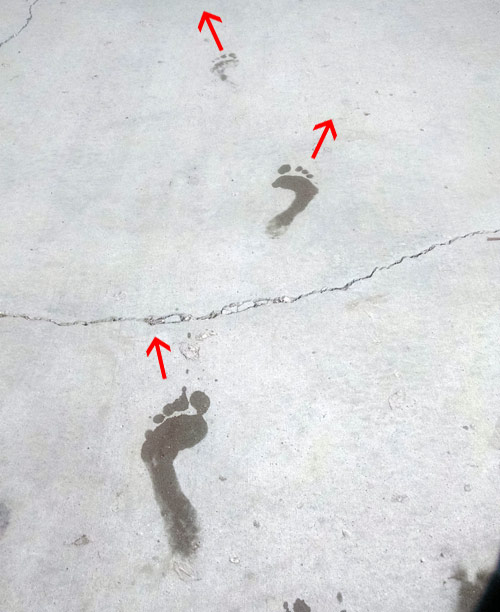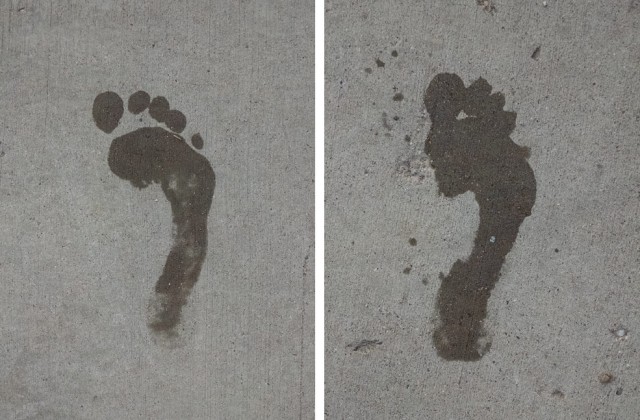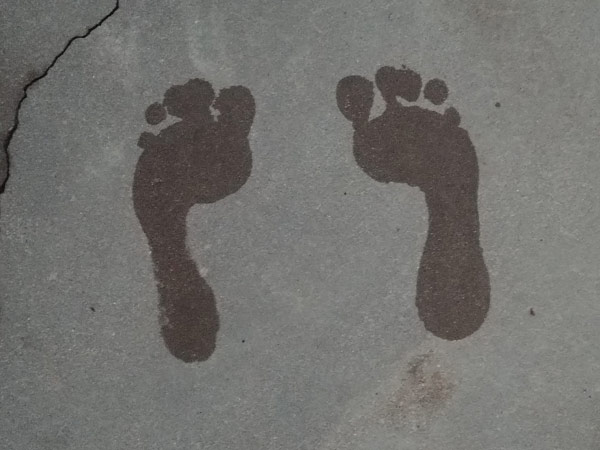Life is about learning. Everything we do has some kind of consequence. We can look at those consequences and then adjust our future actions to better match the consequences that we desire. Looking backwards at the path we have taken can be very beneficial as long as you have the intention to correct your path and then focus on the future path. Of course, this is all metaphorical but when we are talking about biomechanics, we can learn quite a bit from literally turning around and looking back at the path you’ve taken. Here are 4 lessons you can learn by looking at your own footprints
Lesson 1: Foot Alignment
Your feet should point straight forward. If you think about it, it makes perfect sense. If your car tires aren’t aligned forward then they wear out rather quickly. I struggle with this. I tend to let my feet point outward (duck foot!). Sometimes I feel like my feet are aligned nicely but then I look back at my footprints and it is clear that I have been walking with my feet pointed outward.

It’s pretty obvious by this image that the feet are not pointing forward as they ought to be!
Lesson 2: Arch Height
Everywhere we go, people tell us about their various foot ailments. One of the most common ones we hear about are flat feet. People assume that they just don’t have an arch and that is permanent. Of course every case is different and there are a variety of reasons someone might have flat feet but most people do have an arch hiding down there. Step in some water and then step on the concrete and it will show you. Most flat footed people either have wimpy arches from too much support, or they are standing on the side of their arch (more on that later). If your footprint is extremely thin then you probably have pretty high arches, if you have a wide footprint then you probably have less of an arch.
Lesson 3: Leg Alignment
This one is more subtle, but in some cases you can actually see signs of improper leg alignment by looking at a footprint. In the image below, the footprint on the right was made with improper leg alignment. The most common issue we see is that people point their feet outward, and their knees inward. This is a result of weakness in hip, gluteus, and pelvic floor muscles. Notice how the edges on the right footprint are not well defined? This could happen if the ground was unstable but on concrete and a little water, that print should be defined. It is because this foot was turned inward and the weight of the body was more on the inside rather than the bottom of the foot. The foot really can’t properly hold the weight of the body that way and the arch squishes down more when weight is placed on it. This creates a small amount of movement and makes the edges of the print less defined. You can also see that there is more water between the toes and the ball of the foot, especially on the big toe. Again, if you stand this way, you’re standing on the inside of your foot and your toes get forced into a weird position where the they lay more on the sides than the bottom. It can also force your big toe inward over time.

The print on the left is made with the foot and knee pointing forward in proper alignment. The print on the right is improper alignment with the foot pointing outward and the knee pointing inward. This happens when the hips are weak or are not properly holding the leg in place.
If it was done in the sand, you would be able to see that there is much more weight on the inside of the foot. The footprint on the left was made with the foot pointing straight forward, the knee pointing straight forward and the ankle, knee, and hip stacked directly in alignment.
Lesson 4: Imbalances
In the set of footprints below, you can see that the right and left prints are clearly different.
The one on the left is narrower and seems to have a higher arch. There are a variety of things that could be causing this including tight muscles somewhere in the foot or calves but simply looking at the footprint shows that something is out of balance. Our bodies are masters of adaptation so if we get an injury or weakness in one area of the body, the rest of the body quickly adapts to it to compensate. This often happens unconsciously and we don’t even realize it is happening. It can become a habit and then the body is out of balance.

